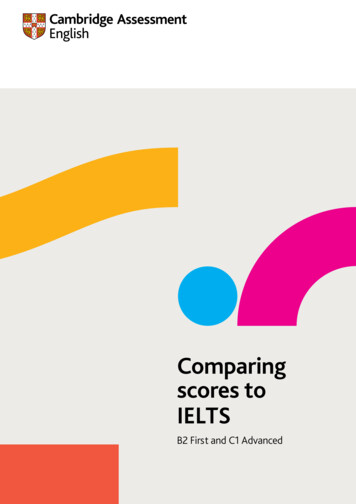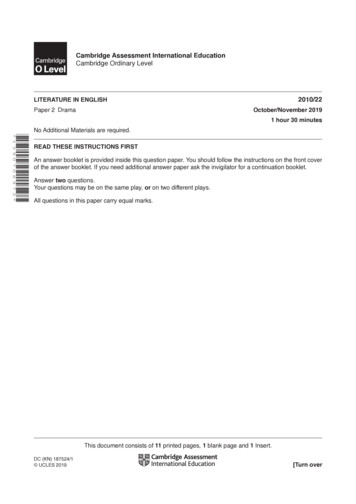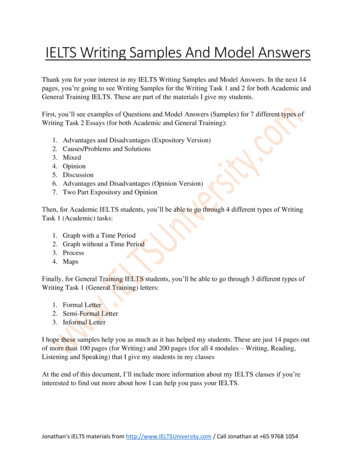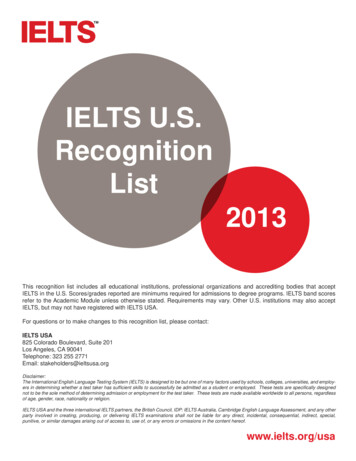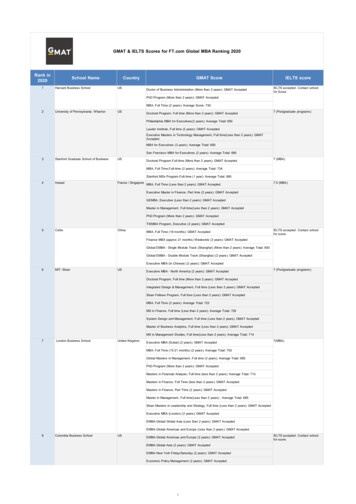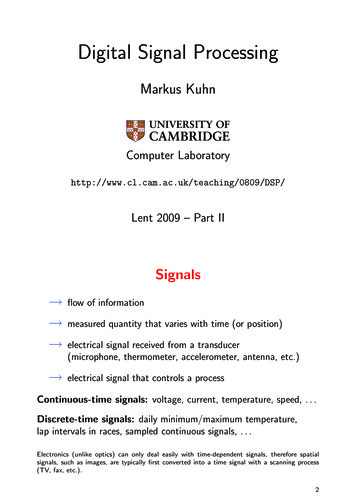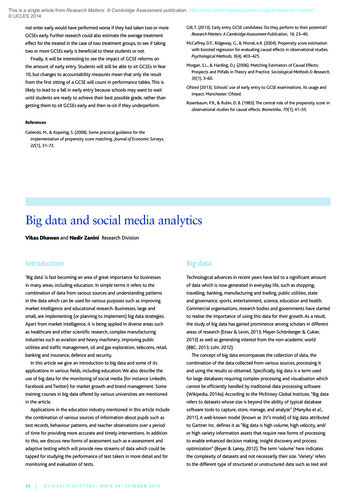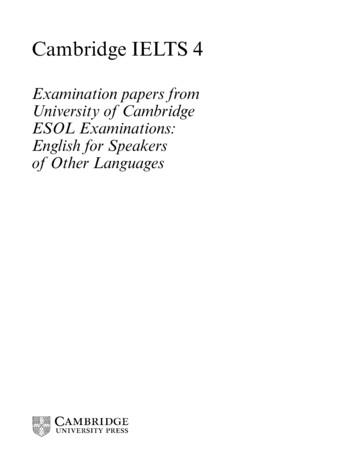
Transcription
Cambridge IELTS 4Examination papers fromUniversity of CambridgeESOL Examinations:English for Speakersof Other Languages
Cambridge, New York, Melbourne, Madrid, Cape Town, Singapore, São PauloCambridge University PressThe Edinburgh Building, Cambridge CB2 2RU, UKwww.cambridge.orgInformation on this title: www.cambridge.org/9780521544627 Cambridge University Press 2005It is normally necessary for written permission for copying to be obtained inadvance from a publisher. The candidate answer sheets at the back of thisbook are designed to be copied and distributed in class. The normalrequirements are waived here and it is not necessary to write toCambridge University Press for permission for an individual teacher to makecopies for use within his or her own classroom. Only those pages which carrythe wording ‘ UCLES 2005 Photocopiable ’ may be copied.First published 2005Printed in the United Kingdom at the University Press, CambridgeA catalogue record for this book is available from the British LibraryISBN-13ISBN-10978-0-521-54462-7 Student’s Book with answers0-521-54462-9 Student’s Book with answersISBN-13ISBN-10978-0-521-54464-1 Cassette Set0-521-54464-5 Cassette SetISBN-13ISBN-10978-0-521-54465-8 Audio CD Set0-521-54465-3 Audio CD SetISBN-13ISBN-10978-0-521-54463-4 Self-study Pack0-521-54463-7 Self-study Pack
ContentsIntroductionTest 110Test 234Test 357Test 4814General Training: Reading and Writing Test A103General Training: Reading and Writing Test B116Tapescripts130Answer key152Model and sample answers for Writing tasksSample answer sheetsAcknowledgements174176162
Test 1XL I STE NI NG XS EC T I ON 1Questions 1–10Questions 1–4Complete the notes below.Write NO MORE THAN THREE WORDS AND/OR A NUMBER for each answer.NOTES ON SOCIAL PROGRAMMEExampleNumber of trips per month:Answer5 Visit places which have: historical interest good 1 2 10Cost:between 5.00 and 15.00 per personNote:special trips organised for groups of 3 peopleTime:departure – 8.30 a.m.return – 6.00 p.m.To reserve a seat:sign name on the 4 3 days in advance
ListeningQuestions 5–10Complete the table below.Write NO MORE THAN THREE WORDS AND/OR A NUMBER for each answer.WEEKEND TRIPSPlaceDateNumber of seatsOptional extraSt Ives5 .16Hepworth MuseumLondon16th February456 .7 .3rd March18S.S. Great BritainSalisbury18th March50StonehengeBath23rd March168 .For further information:Read the 9 . or see Social Assistant: Jane 10 .11
Test 1S E CT I ON 2Questions 11–20Questions 11–13Complete the sentences below.Write NO MORE THAN THREE WORDS AND/OR A NUMBER for each answer.RIVERSIDE INDUSTRIAL VILLAGE11Riverside Village was a good place to start an industry because it had water, rawmaterials and fuels such as and .12The metal industry was established at Riverside Village by who livedin the area.13There were over water-powered mills in the area in the eighteenthcentury.12
ListeningQuestions 14–20Label the plan below.Write NO MORE THAN TWO WORDS for each answer.The17 .The EngineRoomThe GrindingShopThe18 .The19 .RiverYardTheTheStables20 .for theTheWorksOfficeworkersCar ParkThe16 .EntranceThe15 .Toilets14 . Road13
Test 1S E CT I ON 3Questions 21–30Questions 21 and 22Choose the correct letter, A, B or C.ExampleMelanie could not borrow any books from the library becauseABC21Melanie says she has not started the assignment becauseABC22she was doing work for another course.it was a really big assignment.she hasn’t spent time in the library.The lecturer says that reasonable excuses for extensions areABC14the librarian was out.she didn’t have time to look.the books had already been borrowed.planning problems.problems with assignment deadlines.personal illness or accident.
ListeningQuestions 23–27What recommendations does Dr Johnson make about the journal articles?Choose your answers from the box and write the letters A–G next to questions 23–27.ABCDEFGmust readusefullimited valueread first sectionread research methodsread conclusiondon’t readExampleAnswerAnderson and Hawker:A.Jackson: 23 Roberts:24 Morris:25 Cooper:26 Forster:27 15
Test 1Questions 28–30Label the chart below.Choose your answers from the box below and write the letters A–H next to questions 28–30.Population studiesReasons for changingaccommodationg g1009030 C28 8029 7060E5040G3020100123ABCDEFGH164Possible reasonsuncooperative landlordenvironmentspacenoisy neighboursnear citywork locationtransportrent56
ListeningS E CT I ON 4Questions 31–40Complete the notes below.Write NO MORE THAN TWO WORDS for each answer.THE URBAN LANDSCAPETwo areas of focus: the effect of vegetation on the urban climate ways of planning our 31 betterLarge-scale impact of trees: they can make cities more or less 32 in summer they can make cities cooler they can make inland cities more 33 Local impact of trees: they can make local areas– more 34 – cooler– more humid– less windy– less 35 Comparing trees and buildingsTemperature regulation: trees evaporate water through their 36 building surfaces may reach high temperaturesWind force: tall buildings cause more wind at 37 level trees 38 the wind forceNoise: trees have a small effect on traffic noise 39 frequency noise passes through treesImportant points to consider: trees require a lot of sunlight, water and 40 to grow17
Test 1XRE A DI NG XRE AD I N G PASSAG E 1You should spend about 20 minutes on Questions 1–14 which are based on Reading Passage 1below.Adults and children are frequently confronted withstatements about the alarming rate of loss of tropicalrainforests. For example, one graphic illustration towhich children might readily relate is the estimate thatrainforests are being destroyed at a rate equivalent to onethousand football fields every forty minutes – about theduration of a normal classroom period. In the face of thefrequent and often vivid media coverage, it is likely thatchildren will have formed ideas about rainforests – whatand where they are, why they are important, what endangers them – independent of any formal tuition. It is alsopossible that some of these ideas will be mistaken.Many studies have shown that children harbour misconceptions about ‘pure’, curriculum science. These misconceptions do not remain isolated but become incorporated into a multifaceted, but organised, conceptual framework, making it and thecomponent ideas, some of which are erroneous, more robust but also accessible tomodification. These ideas may be developed by children absorbing ideas through thepopular media. Sometimes this information may be erroneous. It seems schools maynot be providing an opportunity for children to re-express their ideas and so have themtested and refined by teachers and their peers.Despite the extensive coverage in the popular media of the destruction of rainforests,little formal information is available about children’s ideas in this area. The aim of thepresent study is to start to provide such information, to help teachers design their educational strategies to build upon correct ideas and to displace misconceptions and toplan programmes in environmental studies in their schools.The study surveys children’s scientific knowledge and attitudes to rainforests.Secondary school children were asked to complete a questionnaire containing fiveopen-form questions. The most frequent responses to the first question were descriptions which are self-evident from the term ‘rainforest’. Some children described themas damp, wet or hot. The second question concerned the geographical location of rainforests. The commonest responses were continents or countries: Africa (given by 43%of children), South America (30%), Brazil (25%). Some children also gave moregeneral locations, such as being near the Equator.18
ReadingResponses to question three concerned the importance of rainforests. The dominant idea, raised by 64% of the pupils, was that rainforests provide animals with habitats. Fewer students responded that rainforests provide plant habitats, and even fewermentioned the indigenous populations of rainforests. More girls (70%) than boys(60%) raised the idea of rainforest as animal habitats.Similarly, but at a lower level, more girls (13%) than boys (5%) said that rainforestsprovided human habitats. These observations are generally consistent with our previous studies of pupils’ views about the use and conservation of rainforests, in whichgirls were shown to be more sympathetic to animals and expressed views which seemto place an intrinsic value on non-human animal life.The fourth question concerned the causes of the destruction of rainforests. Perhapsencouragingly, more than half of the pupils (59%) identified that it is human activitieswhich are destroying rainforests, some personalising the responsibility by the use ofterms such as ‘we are’. About 18% of the pupils referred specifically to logging activity.One misconception, expressed by some 10% of the pupils, was that acid rain isresponsible for rainforest destruction; a similar proportion said that pollution isdestroying rainforests. Here, children are confusing rainforest destruction withdamage to the forests of Western Europe by these factors. While two fifths of the students provided the information that the rainforests provide oxygen, in some cases thisresponse also embraced the misconception that rainforest destruction would reduceatmospheric oxygen, making the atmosphere incompatible with human life on Earth.In answer to the final question about the importance of rainforest conservation, themajority of children simply said that we need rainforests to survive. Only a few of thepupils (6%) mentioned that rainforest destruction may contribute to global warming.This is surprising considering the high level of media coverage on this issue. Somechildren expressed the idea that the conservation of rainforests is not important.The results of this study suggest that certain ideas predominate in the thinking ofchildren about rainforests. Pupils’ responses indicate some misconceptions in basicscientific knowledge of rainforests’ ecosystems such as their ideas about rainforests ashabitats for animals, plants and humans and the relationship between climatic changeand destruction of rainforests.Pupils did not volunteer ideas that suggested that they appreciated the complexity ofcauses of rainforest destruction. In other words, they gave no indication of an appreciation of either the range of ways in which rainforests are important or the complexsocial, economic and political factors which drive the activities which are destroyingthe rainforests. One encouragement is that the results of similar studies about otherenvironmental issues suggest that older children seem to acquire the ability to appreciate, value and evaluate conflicting views. Environmental education offers an arena inwhich these skills can be developed, which is essential for these children as future decision-makers.19
Test 1Questions 1–8Do the following statements agree with the information given in Reading Passage 1?In boxes 1–8 on your answer sheet writeTRUEFALSENOT GIVENif the statement agrees with the informationif the statement contradicts the informationif there is no information on this1The plight of the rainforests has largely been ignored by the media.2Children only accept opinions on rainforests that they encounter in their classrooms.3It has been suggested that children hold mistaken views about the ‘pure’ science thatthey study at school.4The fact that children’s ideas about science form part of a larger framework of ideasmeans that it is easier to change them.5The study involved asking children a number of yes/no questions such as ‘Are there anyrainforests in Africa?’6Girls are more likely than boys to hold mistaken views about the rainforests’destruction.7The study reported here follows on from a series of studies that have looked atchildren’s understanding of rainforests.8A second study has been planned to investigate primary school children’s ideas aboutrainforests.20
ReadingQuestions 9–13The box below gives a list of responses A–P to the questionnaire discussed in ReadingPassage 1.Answer the following questions by choosing the correct responses A–P.Write your answers in boxes 9–13 on your answer sheet.9What was the children’s most frequent response when asked where the rainforests were?10What was the most common response to the question about the importance of therainforests?11What did most children give as the reason for the loss of the rainforests?12Why did most children think it important for the rainforests to be protected?13Which of the responses is cited as unexpectedly uncommon, given the amount of timespent on the issue by the newspapers and television?There is a complicated combination of reasons for the loss of therainforests.B The rainforests are being destroyed by the same things that aredestroying the forests of Western Europe.C Rainforests are located near the Equator.D Brazil is home to the rainforests.E Without rainforests some animals would have nowhere to live.F Rainforests are important habitats for a lot of plants.G People are responsible for the loss of the rainforests.H The rainforests are a source of oxygen.I Rainforests are of consequence for a number of different reasons.J As the rainforests are destroyed, the world gets warmer.K Without rainforests there would not be enough oxygen in the air.L There are people for whom the rainforests are home.M Rainforests are
Printed in the United Kingdom at the University Press, Cambridge A catalogue record for this book is available from the British Library ISBN-13 978-0-521-54462-7 Student’s Book with answers ISBN-10 0-521-54462-9 Student’s Book with answers ISBN-13 978-0-521-54464-1 Cassette Set ISBN-10 0-521-54464-5 Cassette Set ISBN-13 978-0-521-54465-8 .
